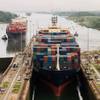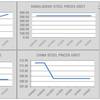Tsakos Q4 & 2009 Results
2009 Highlights:
- Voyage revenues of $444.9 million versus $623.0 million in 2008
- Income of $47.8 million (before vessel impairment charges of $19.1 million) versus $202.9 million (no impairment charge) in 2008
- EPS of $0.77 (diluted) ($1.28 per share excluding impairment charge) compared with $5.33 (diluted) in 2008
- Average operating expenses per vessel per day decreased by 8.2% to $8,677 from $9,450 in 2008
- Accelerated special survey of five tankers initially scheduled for 2010
- Average TCE rate per vessel per day of $22,329 compared with $34,600 in 2008
- Sale of suezmax tanker with a gain of $5.1 million vs. $34.6 million gain on sale in 2008
- Agreement to sell an additional suezmax tanker (delivered in Q1 2010) and agreement to sell two aframax tankers (one delivered in Q1, the other for delivery in Q2 2010)
- Addition of two newbuilding aframax tankers
2009 Fourth Quarter Highlights:
- Voyage revenues of $98.2 million versus $156.1 million in the fourth quarter of 2008
- Income of $2.4 million (before vessel impairment charges of $19.1 million) versus $27.6 million (no impairment charge) in the fourth quarter 2008
- EPS of $(0.45) (diluted) as compared with $0.74 (diluted) in 2008
- Average operating expenses per vessel per day decreased by 9.5% to $8,743 from $9,662 in the fourth quarter of 2008
- Average TCE rate per vessel per day of $18,081 from $33,768 in the fourth quarter of 2008
- Sale of suezmax tanker with a gain of $5.1 million.
- Agreements to sell three further tankers with deliveries in the first half of 2010
- Payment of first semi-annual dividend of $0.30 per share with respect to 2009 operations
Full Year 2009 Results
Income for the year ended December 31, 2009 amounted to $47.8 million (before impairment charges of $19.1 million) compared to the record net income of $202.9 million achieved in 2008. Net income in 2009 including impairment charges was $28.7 million. The decrease is attributable primarily to the lower freight market and the higher fleet exposure to the spot market for the fleet. The commensurate decline in vessel values contributed to impairment charges totaling $19.1 million incurred on the values of the three oldest vessels in the fleet. Diluted EPS based on weighted average number of shares outstanding was $0.77 versus diluted EPS of $5.33 achieved in 2008. Voyage revenues, net of commissions and voyage expenses, were $351.6 million in 2009 compared to $517.0 million in 2008. Income before depreciation was $123.0 million in 2009 versus $288.4 million in 2008.
Revenues from voyages were 28.6% lower compared with 2008, while the average number of vessels in the fleet increased from 44.1 in 2008 to 46.6 in 2009. The average time-charter equivalent (TCE) rate earned per vessel (voyage revenues less voyage expenses) decreased to $22,329 per day in 2009 from $34,600 per day in 2008. TEN’s policy towards fixed employment with minimum base rates and profit sharing agreements as well as the entry into pooling arrangements to secure revenue, enabled the company to achieve a profitable performance in the soft and unpredictable market experienced through much of 2009. Utilization of the fleet was 97.7% during this difficult year compared with 97.3% in 2008, due primarily to fewer days lost to dry-docking requirements, despite the special survey acceleration of the five tankers from 2010 in 2009.
Operating expenses per vessel per day decreased to $8,677 from $9,450 in 2008. This decrease, as a result of the company’s tight cost policy, was primarily due to reduced expenditure on repairs and spares, especially where associated with vessels dry-dockings, and an appreciation of the U.S. Dollar against the Euro, which provided relief to the cost of crew, spares and stores. Overhead expenses decreased to $1,083 per vessel per day in 2009 from $1,514 in 2008 due to reduced G&A expenditure, reduced stock compensation expense relating to stock grants to directors, officers and manager’s staff, and the fact that no incentive award was given for 2009.
Interest and finance costs decreased 45% to $45.9 million in 2009 from $82.9 million in 2008, due mainly to reduced interest rates and positive movements in the valuation of non-hedging interest-rate and bunker swaps. Gain from vessel sales amounted to $5.1 million in 2009 relating to the sale of the suezmax tanker Pentathlon in the fourth quarter compared to gains from vessel sales of $34.6 million from the sale of one vessel in 2008, reflecting the Company’s continued policy of fleet renewal and opportunistic divestments.
Fourth Quarter 2009 Results
Income in the fourth quarter of 2009 was $2.4 million before $19.1 million impairment charges versus $27.6 million in the same quarter of 2008 (no impairment charge). EPS (diluted) based on weighted average number of shares outstanding was $(0.45) in the 2009 fourth quarter versus $0.74 in the same period one year earlier.
Voyage revenues decreased by 37.1% to $98.2 million compared to $156.1 million in the fourth quarter of 2008. This decrease was primarily due to lower freight rates in 2009 compared to the record year of 2008 for tanker revenue, and a larger fleet exposure to spot rate movements. In Q4 2009, total spot market days (spot, contract of affreightment and pool) increased to 1,631 from 721 in Q4 2008. Voyage revenues, net of commissions and voyage expenses, were $74.1 million in the fourth quarter of 2009 compared to $130.31 million in the prior year’s fourth quarter. The size of the Company’s fleet increased to an average of 47.5 vessels from an average of 45.3 vessels in the same period of 2008. Average TCE rates declined to $18,081 per day in the fourth quarter of 2009 from $33,768 in the fourth quarter of 2008.
Efficient cost control measures were evident in the fleet’s operating expenses as they decreased to $37.4 million from $39.0 million in total and on a per vessel per day basis decreased to $8,743 from $9,662 in the fourth quarter of 2008. This decline is mainly due to reduced repair expenditures in the quarter. Overhead costs fell to $1,081 from $1,954, again mainly due to a zero incentive award and reduced G&A expenses.
Interest and finance costs decreased to $8.74 million in the fourth quarter of 2009 from $30.97 million in the fourth quarter of 2008, due to reduced interest rates and positive movements in the non-hedging interest rate and bunker swap valuations as per the company’s hedging strategy.
There was one vessel sale in the fourth quarter of 2009 (the suezmax tanker Pentathlon) which produced a $5.1 million gain, while in the fourth quarter of 2008 there was no vessel sale.
Dividend Distributions
Tsakos Energy Navigation Limited announced on March 15, 2010 that its Board of Directors has declared the Company’s semi-annual dividend of $0.30 per share payable April 29, 2010 with a record date of April 23, 2010.
Mr. Stavropoulos stated, “We are pleased to announce a semi-annual dividend of $0.30 per share. This dividend, which is attributable to TEN’s fiscal 2009 operations, raised the total for the year to $0.60, representing the sixteenth consecutive semi-annual dividend distribution since we listed the Company on the NYSE in 2002.”
Mr. Stavropoulos added, “This latest declaration reaffirms our policy to reward shareowners with generous dividends complemented by periodic share buybacks while reinvesting in the dynamic growth of the enterprise. As always, dividend declarations will be made in the context of the economic and financial environment and the liquidity requirements necessary to maintain our prudent fiscal posture designed to support future needs and growth of the enterprise.”
TEN intends to continue to pay cash dividends representing between one-quarter and one-half of ordinary net income. Such payments are subject to the discretion of the Board of Directors and depend on available cash, anticipated cash needs, overall financial condition, loan agreement restrictions, capital commitments, future prospects for earnings and cash flows, as well as other relevant factors. The Company pays a semi-annual dividend for a given fiscal year in October of that year and in April of the following year.
TEN will have distributed $8.175 per share in dividends to its shareholders since the Company was listed on the NYSE in March of 2002. The listing price at the time was $7.50 per share accounting for the 2-1 share split of November 14th, 2007.
The historical record of dividends attributable to each fiscal year of operations since initiation of cash payments and accounting for the 2-1 stock split effected on November 14, 2007 is as follows:
Fiscal Year of Operations Cash Dividends
2002 $0.35
2003 $0.50
2004 $0.825
2005 $1.05
2006 $1.375
2007 $1.725
2008 $1.750
2009 $0.60
During 2009, the Company suspended its share buyback program and in December initiated an at-the-market share issuance program with the objective of selling 3,000,000 shares of common stock with use of proceeds including fleet expansion and general corporate purposes. Actual sales of shares were limited in December to only 17,394 shares raising under $0.3 million, net. In January of this year until temporary suspension of the program, 660,206 shares were sold for a total of $11.4 million, net.
Strategy & Outlook
2009 was the most challenging year the tanker market has experienced in recent memory. The unprecedented synchronized global economic recession led to a second consecutive year of decreased world oil demand which, coupled with considerable OPEC production cuts and large newbuilding inflows, created an air of uncertainty that pushed spot rates, across the board, at levels near or below vessels’ operating expenses. Assets values also declined, although not at levels reflective of the precipitous drop in rates. This resistance together with some positive reversal in rates at the end of 2009 resulted in a slight but noticeable resurgence in second hand transactions. During this period, and without firm signs of a sustainable recovery, TEN refrained from venturing into any expansion projects and focused on fleet renewal practices instead. This entailed the sale of four vessels, two 2003-built aframaxes, in light of the two higher spec DNA aframax deliveries in April and July of 2010, and two 2002-built suezmaxes, reflecting a newbuilding order for two suezmax newbuildings to be delivered in the second quarter of 2011, at prices well below their historical highs established in 2008. All expected net proceeds after debt repayments from these sales, approximately $120 million, will be available for reinvestment. Furthermore, in the last quarter of 2009, TEN recognized impairment charges totaling $19.1 million relating to two 1990-built panamax tankers (Hesnes and Victory III) which are in the market for sale, and the 1991-built aframax tanker Vergina II. At December 31 2009, therefore, of the six vessels mentioned above as being considered for sale, one had actually been delivered to new buyers in 2009 and the other five vessels were classified as being held for sale in the Company’s consolidated balance-sheet (two being delivered to buyers in the first quarter of 2010).
Cash preservation and accumulation was again the cornerstone of our philosophy and strategy. By the end of 2009, despite the significant fall in charter rates in that year, dividend payments and a continuing, albeit reduced, newbuilding program, our cash position remained near $300 million. This level will be further enhanced by the proceeds of the above mentioned sales. This strong buffer should enable the company to further explore acquisition opportunities that might transpire either in the secondhand or newbuilding front, and to continue adherence to the dividend policy.
Management, aware that difficult markets impose an additional obligation to ensure that costs are effectively controlled in order to generate economies, has been encouraged by the reductions in 2009 of both operating and overhead expenses per vessel per day. It has also enthusiastically welcomed the recent announcement by the technical managers of the fleet, Tsakos Shipping & Trading, that it has formed a joint-venture company with the highly regarded German-owned shipmanagement company Columbia ShipManagement, which will be known as Tsakos Columbia ShipManagement. The new entity will assume the technical management of TEN’s fleet by the middle of 2010 and it is expected that it will be able to exploit much expanded economies of scale resulting from the cooperation and other efficiencies and safeguards arising from a larger potential pool of seafarers. The venture will also put TEN in a better position as the company continues to expand its fleet.
In terms of vessel employment, the company will strive to maintain a material portion of its fleet in secured employment and continue to engage vessels in pooling arrangements as a precaution to a down market. Once markets begin to normalize and provide evidence of a sustainable recovery, it is expected that, given a choice of chartering arrangement, medium to longer term charters, including those with profit sharing arrangements, will be favored. To date, TEN has 31 vessels under fixed charters and charterers with profit-sharing options and assuming only the minimum rate on the profit-sharing contracts, these vessels are expected to generate revenues of $288 million over the duration of their contracts.
Looking ahead, TEN will continue to work closely with international oil majors and end users and always look for ways to mitigate the volatility of the sector. With its strong banking relationships and continued ability to access the debt and equity markets, TEN remains committed to its policy of prudent growth and sustainable revenues going forward.
(www.tenn.gr)










